- In February of this year at the Yokohama Dance Collection EX2012 you presented your new work Hebi no Shinzo (Snake’s heart) in the performance program for the competition’s 2011 New Choreographer Division winners. It was a solo piece and we are told that the stage art, lighting and music were all based on your own ideas. The stage floor was sectioned off into 12 squares like a checker board and in the darkness light would fall on one square at a time and you would enter that square to dance for a while. Each square also had different music that created completely different atmospheres. The piece was of a high level, from both a compositional and technical standpoint, and overall it was quite a strong work. What is the meaning in title?
- In the constellation Hydra (the sea snake) there is one very bright star named Alphard that stands out alone in the position of the snake’s heart. All the other stars around it are dim, which makes Alphard look quite lonely. When I investigated it I found out that it is in fact called the lonely star and I chose it as the title to express loneliness or solitude.
- So, you had an interest in astrology?
- No. That isn’t the case. Since I have to explain my works, I make up the titles afterward, with all my pieces. People won’t be satisfied unless I make some explanation like, “I wanted to do a piece expressing loneliness or solitude,” or “constellations” or something (laughs). I am not one who thinks up concepts and then creates a work around it.
- For example, as you as you danced through that space of squares, when you stepped into a square its lighting would come on like a touch panel. Was that you idea too?
- Yes. I told the technical staff that I wanted to create perceptions with my footsteps and asked them to design that device. I gave each square a number and worked the plan up out on my computer. I also created the sound [for each square] myself. A different piece of music comes on in each square. And it is written on the surface.
- For the square that says “Ayumi Hamasaki,” what kind of music is it?
- I don’t know it very well but it comes from a CD of a selection of Hamasaki songs rearranged in a Euro-beat style.
- What about the square that says Nijyusankaiki?
- It is a recording I made of the priest chanting Buddhist scripture at a Nijyusankaiki ceremony (Buddhist memorial ceremony held on the 23rd anniversary of the death of a family member) at our family home. The one that says “Beat” is something I drummed out “zoon ka, zoon ka, zoon ka, ta ta.” And “Shinsei” is a tune I played myself on a MIDI keyboard. For the square named “Black hole” I used a recording I made of a politician making a campaign speech at a station. For the Yume Nikki square I used the music of the Yume Nikki computer game.
- What about the “Chopin” square’s music?
- At the age of 13, I went to a concert by the Chopin Contest winning pianist Maurizio Baglini and was deeply moved by his music. On the way home I bought a CD of his that I listened to for a long time afterward. Now I have finally been able to dance to it.
- It was very unique and interesting to see you doing you street-based dance under spot lights through all these changes in music, from Chopin to Ayumi Hamasaki and a priest chanting scripture. Your “creating perceptions with your footsteps” gives birth to a work of dance. Could you tell us more about the process by which the ideas in your mind become dance?
-
How can I describe it? I would like to be able to talk about it in a logical way, but in fact it come unconsciously. When I am thinking about images night and day and making sound or music tracks, two or three weeks can go by in no time. If I let myself go on like that in a daze I sometimes find myself just two days away from a performance [without a piece finished]. There are also lots of ideas that I drop along the way. For this [Hebi no Shinzo] works as well, there was a recording I made of airplanes taking off that I never used. I also ended up not using any of the video I had made.
I often use Excel when I am working on the overall flow of a dance piece. I like the [computer] game Tetris, I guess I can play it as well as anyone. Because it’s also a game that you can play alone. So, I like to express things in a form that is put together like that. - With Hebi no Shinzo, did you have an idea of what kind of music or sound you wanted to use beforehand?
-
Well, I would say that it is rather a case where I have this picture stuck in my mind tat I just have to use. Isn’t that the way it is? In a negative sense you could say that I get fixated on that picture and can’t get beyond it. I tend to just refer to it as creating a world of my own.
For me it is not just dance. I like singing and drawing pictures and creating video pieces too. So, I have clear images but I don’t really have the feeling that I am creating [composed] dance pieces.
When discussing things in a meeting with the creative staff, I’ll be jumping around and saying things like, “Ponn (touch) this square.” And the others will be saying, “OK, we see. Why don’t you just sit down.” (Laughs) - So, things come to you in the form of images of the worlds you want to create?
- Just call me a girl playing in a world of her own imagination (laughs). It seems to me that the actual world is an amazing thing with any number of parallel world’s existing at the same time. For example, I think, “If I had just ordered strawberry tea instead of Oolong tea I the world might be different right now.” Or, if I hadn’t come here today the world might be different. In that way the world is changing at every turn and a different me is there. I feel like I am creating those types of parallel worlds.
- I would like to ask you about the work Muku (peel [off]) that won you the Yokohama Dance Collection EX award. It was a very powerful work that starts in the dark with you singing Ave Maria in an almost reptilian rasp and that is overlaid with the soundtrack of a woman’s moans of ecstasy from a porn movie.
- At that time I was originally doing a dance to music from [the anime] Evangelion or something and then afterward change to sound to something different. I had never seen an adult video at the time but I went to a video shop and rented some to use. I tried using some noise type sounds but eventually got into it and started creating the sound from wavelengths.
- From what you have said earlier I things you create in an unconscious mode rather than in a calculated way, but the contrast between the noise-type sound parts and the part with the overlay of Ave Maria and the porn actress’ moans was very sharp and left a strong impression. I would have thought that using that porn soundtrack so long in the piece might have hurt your chances of winning the New Choreographer Division award, so I am also impressed by the keen eyes of the jury that selected your work for the prize. In both Muku and Hebi no Shinzo I found that you had a unique way of using darkness. You connect the parts of these works with quite long intervals of darkness where the lights are off completely. What is your intend in that? From the audience we don’t know where you will move to next, what kind of movement you will appear with or what kind of sound will come with it. Normally, too long a pause of darkness seems unnatural, but your repeated use of those dark pauses in our works becomes effective.
- There is no intent. It’s because I’m a mysterious woman (laughs).
- Do you continue dancing when the lights are off in those intervals?
- Yes, I do. In Hebi no Shinzo I am dancing as I move to different position in the dark.
- In the performance you did at the “DANCE/NESTmore” program at Nakano RAFT in March you completely left the stage at one point. Your absence was so long that I began to think that for some reason you had quit the performance in the middle and would not return (laughs). I heard you ran all the way to Yamate Boulevard.
- For that performance I wanted to do a collection of short pieces. When I left is was for the short piece “A girl goes to Yamate Boulevard. I really did run all the way there and back, and it took about five minutes.
- Other dancers would probably use a video stream of them running outside to explain their absence to the audience, but you just left, leaving only a stuffed toy monkey on the stage (laughs).
- I heard that after I left it apparently became a situation of a group of adults looking at a monkey, and then a feeling of yourself looking at a group of adults looking a monkey spread through the audience (laughs).
- You also won the New Artist Prize at the “Dance ga Mitai! series at Kagurazaka die pratze. Unfortunately, I missed that performance. Would you tell us about your winning work Gambattanda-ne, Omae no naka de wa?
- That work is one in which I set down a radio on the stage and had it playing a talk program. As I listen to that I am eating a box lunch from a convenience store and then vomiting back up what I eat, over and over. On the radio, the DJ Machiko and the singer songwriter Say Plex are talking about sexual relationships, and I performed the voice parts for both of these characters myself. Machiko asks Say Plex about the original of are artist name. Say Plex explains that she originally wanted to use the name Sex Play but her promotion agency got angry with her about that choice and ended up changing the letters around to make the Say Plex anagram. The president of the agency is a strange guy and he took all of the leads out of the mechanical pencils and broke them in half and put them back in. It was her way of saying the president had given in on her name request at least partially (using a play on the two meanings of the Japanese word oreru, which are to give in and to break something). Listening to stories like that I would then vomit up the lunch I had been eating.
- How long was that piece?
- In all about 23 minutes, but the eating and vomiting part was only about 15 minutes of that.
- Thinking back to the “parallel world” you were talking about earlier, if things were turned out differently you might be the singer Say Plex or the DJ Machiko. Or you might have been someone who vomits back up the lunch she eats.
-
Yes, yes, yes … that’s the way it feels! And I can’t get away from that idea, unfortunately. And then they are all connected with something like weird puns. Eating is also a form of sexual activity, right?
Before I performed this piece at die pratze I had performed somewhere else with a piece where I am continuously beating my left leg. That had been a three-day performance, so my leg was full of bruises. - Now that you mention it, you also had a work where you were constantly beating your head, didn’t you? In all of these cases, your dancing and eating and listening and talking and punishing your body and running outside the theater, they must all be your own worlds. Can I ask, when was it that you began to think that there is another you in these parallel worlds?
- Well, it has always been that way. Both my parents had jobs, so I was always playing by myself as a child, and it’s still the same now. From the time I was little they had me taking all kinds of lessons. I had piano lessons from the age of three to the age of fifteen, I continued to study calligraphy lessons for a long time and earned an artist’s name of Kawamura Shisui in calligraphy. I also had lessons in computer and did swimming and basketball. I also went to cram school, and with all of these lessons it filled up my weekly schedule completely. So, I didn’t spend much time just playing with friends, and that also remains the same today.
- All of those experiences must have contributed to the multi-faceted world of imagination we see in your work today. Speaking of childhood lessons, many female dancers in Japan today took ballet lessons when they were young. Didn’t you ever study ballet?
- I never did. When I was in high school I was in the clothing design club and got into making lace. I brought some photos of the lace I’ve knit. Would you like to see them? These are pieces of lace I did over a long period working constantly on the theme of dandelions.
- This is amazing! You could make a profession of this, too.
- Yes. That’s why the people around me though I would eventually study to become a designer. But, when I went to high school I quit all the things I had been taking lessons in until then and decided I was going to do street dance. For us at the time, dance meant street dance. There was a skyscraper in the Shinjuku district with a square in front of it where young people who were into street dance gathered, so I hung out there and had the older boys teach me the moves. I also went to a school that taught street dance.
- There are a variety of techniques in street dance like hip hop, rock, pop and house. Was there one particular style that you specialized in?
- I learned them all to some degree, but what I did best in was the styles like pop. But basically I don’t think I’m a very good dancer. But, when I started dancing at clubs I met a lot of people and learned that there was a good dance department at the Japan Women’s Physical Education University, so I decided to go there.
- What made you decide to do dance in the first place?
-
Well, I don’t know whether I was three or five but I made up a dance where I got up on the kotatsu table and danced saying, “It’s strange, it’s strange, there is a loud noise, don-don.” That might have been the start of it all. Anyway, I feel that I have always been doing things like that. But, it is also a strange fact that I have never really thought of myself as someone who likes dance. But, I do like singing. If I became a singer I could have sung song I wrote, and I could dance as well, make promotional videos ….
I guess I’m a person who just wants to have it all. When I was a child, there were mushrooms made with gum tape that were handed our to all the children at the school athletic festival. The mushroom that the girl Mika next to me got was bigger than mine and it was pink and really pretty. So, I switched for my small one. Isn’t it frightening to think that you can do that kind of greedy thing, even when there is not any evil intent? So, I’m now on a campaign to rid myself of [greedy] desire.
Under the skin, human beings are mostly water, right? Of course there are bones and muscle and internal organs. But, if this plastic bottle full of water were my “body” and the water inside were full of dirt and debris, I would think, “How revolting,” wouldn’t I? And I think other people looking at would feel the same way. You would also get the feeling that this medium full of dirt and dust wouldn’t conduct electricity very well, wouldn’t you? But, when the water is clean and transparent like the water in this bottle, it looks like the electricity would just zip through it beautifully. So, I want to have my body in that type of condition where I feel, “That elbow really moves well,” or, “these shoulders really move,” just like electric impulses zipping through a conductive medium. I want free myself of desire and made my body beautiful in that sense [of a clear medium] for people to see. - You just said that you don’t think you are a skilled dancer, but when we watch you perform your works we are impressed by the movements you put all parts of your body through. It is amazing the way your back muscles, or your shoulders or hips all move with different types of expressiveness. So, it must be the ideals you have just described that make us feel that your movements come from the very core of your body. Is there any particular training you do to make your body a beautiful thing in that sense you have described?
- Yes, there is.
- What kind of training is it?
- It’s making love with someone I am fond of. I am content to learn technique from others, but regarding my body, I believe it is my responsibility to train and take care of it properly. Then, when I have rid myself of all my desires in life, I think I’ll open up a novelty shop [that sells variety goods].
- That ideal of ridding yourself of desire is related to the original teachings of Buddhism, isn’t it? Being alive brings unsavory aspects of existence itself, and life [and desires] always brings times of suffering. What’s more, life brings aging and illness and desires lead you on the wrong path at times. So, we want to free ourselves from all this. When you create your works, is it with that kind of need within you to drive out the [bad] desires and things you dislike from within you?
- Well, I don’t know. In the past, I have had the feeling that the audience is serving a witness to my process of cleansing myself, but now I feel it is not that way. There is still so much I don’t know….
- May I also ask you if there is anything that effects you in an inspirational way, such as music?
- As a matter of fact, I feel that my ears are very sensitive. I am very sensitive to sounds. So, for example, I have had the experience of standing in front of a pachinko parlor absorbed by the sounds when the automatic door opens and closes. There is always loud music playing in the pachinko parlor, and for some reason the volume of that sound always increases slightly just as the doors slide shut. I became so absorbed in that audible phenomenon that I stood there for the longest time and then realized that evening had come.
- Is sound an important inspirational element during your creative process?
- Yes. I think sound has a tremendous amount of [communicative] information capacity. In cases like the Euro-beat Ayumi Hamasaki music I used in Hebi no Shinzo, I feel that I am dancing to parts that normally would be unthinkable [in a dance work].
- You graduated from university in March of this year.
-
Yes. And I am very grateful to the people I met there.
I did some [bad] things, like the time I performed as one of the university’s representative dance students in front of the middle school and high school students that had come to compete in the “National Middle School and High School Dance Competition” that our university our university organizes. I shouted into the microphone at them, “Listen all of you, doing dance is meaningless.” I also brought unrelated people up on stage and I took a metal pipe and smashed a plastic bucket to the accompaniment of Chopin’s Heroic Polonaise until it broke. The university made me write a letter of apology for that. At university I had to do [dance] with other people (the other dance students) and I felt some danger in that. You don’t know what to expect and it isn’t in the same area you wanted it to be. I felt like I was being violated to some degree. I felt that I wasn’t as mentally tough as I should be.
However, I also felt like I was being told that it was time to stop playing in my own separate world. Well, in the end I am going to run a novelty shop, so I feel that it is just a question of what I can do before I reach that point. I like making film, so I want to be a film director too.
I want to do a lot of different things. Because if I don’t, I feel like I might die. - We hear that you have performances scheduled in Finland, Germany, the Netherlands and South Korea. We also hear that you will be performing at the Dance Triennale Tokyo 2012. We look forward to your activities from now on.
Mikiko Kawamura
Dancing a parallel world -
What an emerging face of the new generation has to say
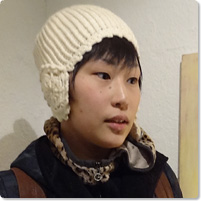
Mikiko Kawamura
Mikiko Kawamura is an emerging artist who, as a student at Japan Women’s College of Physical Education, submitted a work to the New Choreographer Division of the Yokohama Dance Collection EX2011 competition and won the Outstanding New Artist Prize. A year later she won the New Artist Prize at the “Dance ga Mitai! New Figure Dance Festival 10” and continued to draw attention as a new face in Japan’s street dance scene with a unique presence. Calling herself a girl playing in an imaginary world, Kawamura’s dance expresses a world where her alter-ego latent with hidden sexuality, violence and desire runs free.
[Interviewer: Tatsuro Ishii (dance critic)]
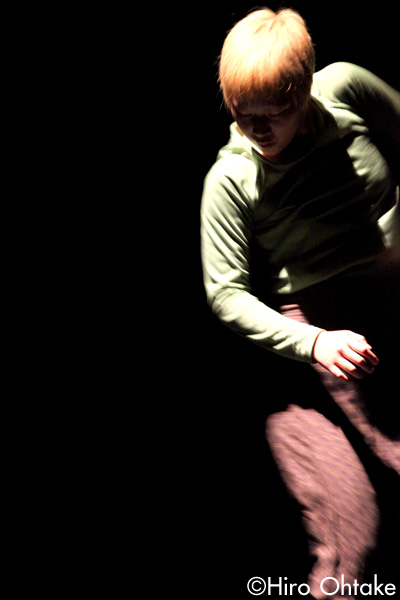
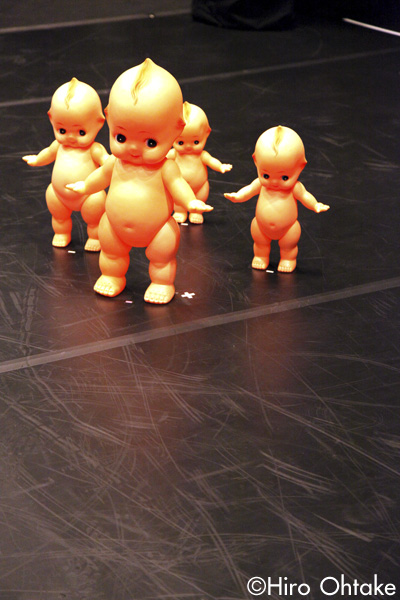
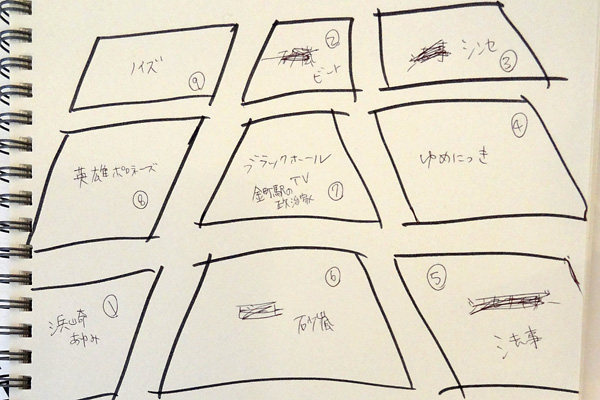
Progress table of Hebi no Shinzo
Hebi no Shinzo (Snake’s heart)
Yokohama Dance Collection EX2012
(Feb. 12, 2012 at Yokohama Red Brick Warehouse 1st Building’s hall)
Photo: Hiro Ohtake
Muku
Seoul International Dance Festival
(Oct. 10, 2011 at Seoul Mary hall, Sogang, Univ)
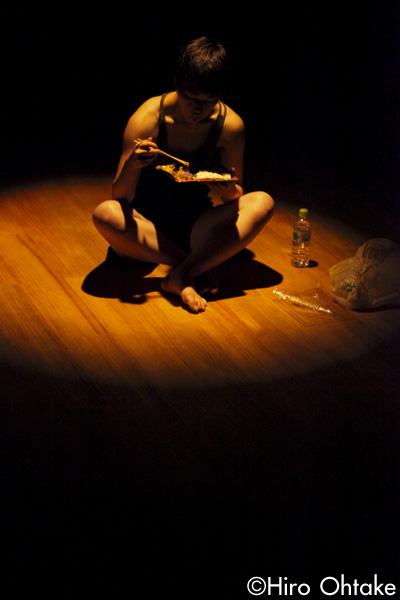
Gambattanda-ne, Omae no naka de wa
“Dance ga Mitai! New Figure Dance Festival 10”
(Jan. 7, 2012at Kagurazaka die pratze)
Photo: Hiro Ohtake
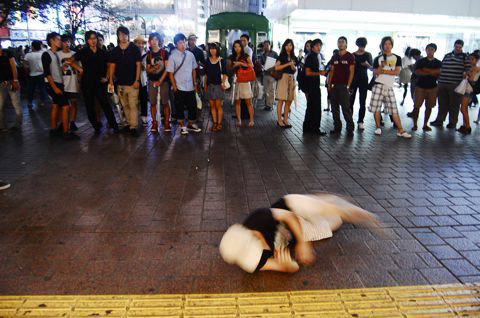
Performance at Shibuya station (2011)
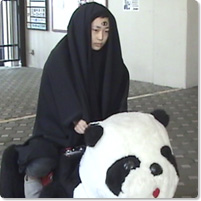
Jako no Uta
Video work was featured in the program of NHK Educational TV.
Related Tags

